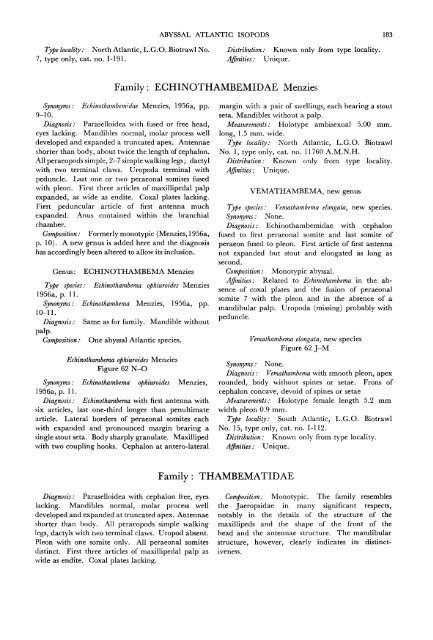The Isopods of Abyssal Depths in the Atlantic Ocean
The Isopods of Abyssal Depths in the Atlantic Ocean
The Isopods of Abyssal Depths in the Atlantic Ocean
You also want an ePaper? Increase the reach of your titles
YUMPU automatically turns print PDFs into web optimized ePapers that Google loves.
Type locality: North <strong>Atlantic</strong>, L.G.O. Biotrawl No.<br />
7, type only, cat. no. 1-191.<br />
ABYSSAL ATLANTIC ISOPODS 183<br />
Distribution: Known only from type locality.<br />
Aff<strong>in</strong>ities: Unique.<br />
Family: ECHINOTHAMBEMIDAE Menzies<br />
Synonyms: Ech<strong>in</strong>othambemvdae Menzies, 1956a, pp.<br />
9-10.<br />
Diagnosis: Paraselloidea with fused or free head,<br />
eyes lack<strong>in</strong>g. Mandibles normal, molar process well<br />
developed and expanded a truncated apex. Antennae<br />
shorter than body, about twice <strong>the</strong> length <strong>of</strong> cephalon.<br />
All peraeopods simple, 2-7 simple walk<strong>in</strong>g legs; dactyl<br />
with two term<strong>in</strong>al claws. Uropoda term<strong>in</strong>al with<br />
peduncle. Last one or two peraeonal somites fused<br />
with pleon. First three articles <strong>of</strong> maxillipedal palp<br />
expanded, as wide as endite. Coxal plates lack<strong>in</strong>g.<br />
First peduncular article <strong>of</strong> first antenna much<br />
expanded. Anus conta<strong>in</strong>ed with<strong>in</strong> <strong>the</strong> branchial<br />
chamber.<br />
Composition: Formerly monotypic (Menzies, 1956a,<br />
p. 10). A new genus is added here and <strong>the</strong> diagnosis<br />
has accord<strong>in</strong>gly been altered to allow its <strong>in</strong>clusion.<br />
Genus: ECHINOTHAMBEMA Menzies<br />
Type species: Ech<strong>in</strong>othambema ophiuroides Menzies<br />
1956a, p. 11.<br />
Synonyms: Ech<strong>in</strong>othambema Menzies, 1956a, pp.<br />
10-11.<br />
Diagnosis: Same as for family. Mandible without<br />
palp.<br />
Composition: One abyssal <strong>Atlantic</strong> species.<br />
Ech<strong>in</strong>othambema ophiuroides Menzies<br />
Figure 62 N-O<br />
Synonyms: Ech<strong>in</strong>othambema ophiuroides Menzies,<br />
1956a, p. 11.<br />
Diagnosis: Ech<strong>in</strong>othambema with first antenna with<br />
six articles, last one-third longer than penultimate<br />
article. Lateral borders <strong>of</strong> peraeonal somites each<br />
with expanded and pronounced marg<strong>in</strong> bear<strong>in</strong>g a<br />
s<strong>in</strong>gle stout seta. Body sharply granulate. Maxilliped<br />
with two coupl<strong>in</strong>g hooks. Cephalon at antero-lateral<br />
Diagnosis: Paraselloidea with cephalon free, eyes<br />
lack<strong>in</strong>g. Mandibles normal, molar process well<br />
developed and expanded at truncated apex. Antennae<br />
shorter than body. All peraeopods simple walk<strong>in</strong>g<br />
legs, dactyls with two term<strong>in</strong>al claws. Uropod absent.<br />
Pleon with one somite only. All peraeonal somites<br />
dist<strong>in</strong>ct. First three articles <strong>of</strong> maxillipedal palp as<br />
wide as endite. Coxal plates lack<strong>in</strong>g.<br />
marg<strong>in</strong> with a pair <strong>of</strong> swell<strong>in</strong>gs, each bear<strong>in</strong>g a stout<br />
seta. Mandibles without a palp.<br />
Measurements: Holotype ambisexual 5.00 mm.<br />
long, 1.5 mm. wide.<br />
Type locality: North <strong>Atlantic</strong>, L.G.O. Biotrawl<br />
No. 1, type only, cat. no. 11760 A.M.N.H.<br />
Distribution: Known only from type locality.<br />
Aff<strong>in</strong>ities: Unique.<br />
VEMATHAMBEMA, new genus<br />
Type species: Vemathambema elongata, new species.<br />
Synonyms: None.<br />
Diagnosis: Ech<strong>in</strong>othambemidae with cephalon<br />
fused to first peraeonal somite and last somite <strong>of</strong><br />
peraeon fused to pleon. First article <strong>of</strong> first antenna<br />
not expanded but stout and elongated as long as<br />
second.<br />
Composition: Monotypic abyssal.<br />
Aff<strong>in</strong>ities: Related to Ech<strong>in</strong>othambema <strong>in</strong> <strong>the</strong> absence<br />
<strong>of</strong> coxal plates and <strong>the</strong> fusion <strong>of</strong> peraeonal<br />
somite 7 with <strong>the</strong> pleon and <strong>in</strong> <strong>the</strong> absence <strong>of</strong> a<br />
mandibular palp. Uropoda (miss<strong>in</strong>g) probably with<br />
peduncle.<br />
Vemathambema elongata, new species<br />
Figure 62 J-M<br />
Synonyms: None.<br />
Diagnosis: Vemathambema with smooth pleon, apex<br />
rounded, body without sp<strong>in</strong>es or setae. Frons <strong>of</strong><br />
cephalon concave, devoid <strong>of</strong> sp<strong>in</strong>es or setae<br />
Measurements: Holotype female length 5.2 mm<br />
width pleon 0.9 mm.<br />
Type locality: South <strong>Atlantic</strong>, L.G.O. Biotrawl<br />
No. 15, type only, cat. no. 1-112.<br />
Distribution: Known only from type locality.<br />
Aff<strong>in</strong>ities: Unique.<br />
Family: THAMBEMATIDAE<br />
Composition: Monotypic. <strong>The</strong> family resembles<br />
<strong>the</strong> Jaeropsidae <strong>in</strong> many significant respects,<br />
notably <strong>in</strong> <strong>the</strong> details <strong>of</strong> <strong>the</strong> structure <strong>of</strong> <strong>the</strong><br />
maxillipeds and <strong>the</strong> shape <strong>of</strong> <strong>the</strong> front <strong>of</strong> <strong>the</strong><br />
head and <strong>the</strong> antennae structure. <strong>The</strong> mandibular<br />
structure, however, clearly <strong>in</strong>dicates its dist<strong>in</strong>ctiveness.

















